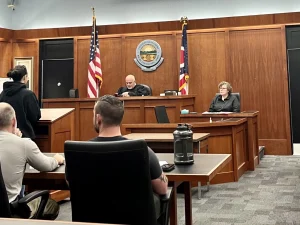News
Here’s an Ohio task force’s recommendations for supporting reentry
By: Kendall Crawford | The Ohio Newsroom
Posted on:
COLUMBUS, Ohio (The Ohio Newsroom) — Around 18,000 people were released from Ohio’s prisons in 2022. Another 75,000 Ohioans were released from jail that year.
When they return to Ohio’s communities, many face obstacles in finding housing, employment and healthcare. For the last year and a half, an Ohio Supreme Court task force has been examining how to best help these formerly incarcerated Ohioans reenter the rest of society.
The taskforce released its final report, recommending 16 action items from Ohio’s executive, judicial and legislative branches. Many focus on curbing barriers to housing, employment and healthcare that incarcerated Ohioans face upon release.
“It’s all about successful reintegration, because that drives recidivism down, that strengthens our communities. These things go hand-in-hand,” said Stark County judge Chryssa Hartnett, who chaired the Reentry Task Force.
Top takeaways on the reentry report
1. Expand reentry courts
The taskforce wants to see an expansion of reentry courts across the state.

There are only 10 of these specialized dockets in Ohio. And six of Ohio’s counties do not grant judicial release at all, according to the report.
“I think a lot of that is tied into the stigma of reentry, the community stigma of prison. But there’s almost like a judicial stigma of a judge who’s willing to give someone an opportunity.”
“I do think it is a good idea – if not a requirement of a judge – to try to figure out how we can make our community better, how we can balance that punishment with rehabilitation and try to then strengthen the community with that,” Hartnett said.
2. Revisit housing policies
The taskforce also promotes an emphasis on removing barriers to housing for formerly incarcerated Ohioans, including the creation of a statewide workgroup to revisit housing policies. It also suggests the court explore funding options to incentivize landlords to rent to formerly incarcerated individuals.
Hartnett said housing is one of the biggest challenges upon release from prison, and the state needs to go beyond just helping individuals to tackle the issue.
Hartnett said the question is “how do we get information and education out there to go after this sort of stigma of prison and be able to benefit not only the citizens coming back, but the community as a whole.”.
3. Expand eligibility for record sealing
The report also suggested the state take legislative action. The task force recommends the state join in the national “Clean Slate Initiative,” which expands eligibility for record expungement. The national effort to adopt automatic record sealing for eligible offenses has been adopted in 12 states.
Hartnett said criminal records can often prevent people from landing a job and that can have a ripple effect.
“Their housing was dependent upon having this income and then now they don’t have a job and now they’re worried about everything,” Hartnett said. “It can really be devastating.”
She said state lawmakers should take steps to streamline the record sealing process to ease returning citizens in their search for employment and housing.

